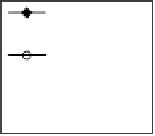Geology Reference
In-Depth Information
mostly from space‐borne passive microwave data
(
Drobot and Anderson
, 2001;
Belchansky et al
., 2004;
Markus et al
., 2009].
continued to decrease during the melt pond period.
Between 19 June and 21 June the received TOA reflec-
tance from AVHRR channels 1 and 2 decreased from
0.67 to 0.50 and from 0.47 to 0.29, respectively. The
pond fraction increased from 0% to 45% during this
period. Surface drainage was first observed on 24 June
and resulted in a decrease in melt pond fraction but the
high rate of drop in reflectance continues until June 26.
As the drainage stage progresses, the enlarged brine
pockets interconnect to form vertical drainage pathways
to the underlying water. Moreover, the ice becomes lit-
tered with cracks and seal holes. All these processes
accelerate surface meltwater to drain vertically through
the ice, leaving much less surface area covered by water.
De Abreu et al
. [2001a] also reported that the newly
uncovered remnant ice surface is often dry, crumbly, and
dull white in color. That is the reason for the increasing
reflectance during the second week of July as shown in
Figure 9.13. It should be mentioned that the surface melt
can also be identified by the increased difference between
reflectance from AVHRR channels 1 and 2 when com-
pared to the winter dry surface reflectance (reflectance is
almost equal from AVHRR 1 and 2 but not shown in the
figure). This difference is manifested by the change in the
color of sea ice when observed in color composite images
of channels 1 and 2.
As mentioned before, melt ponds are formed on sea
ice surface during the advanced melting stage when
the atmospheric temperature exceeds the ice melting
temperature especially if ice is covered by snow [
Grenfell
9.3.1. Optical Satellite Observations
Broadband albedo from melting ice surface and melting
snow is presented in Tables 8.8 and 8.9 and spectral albedo
is shown in Figure 8.23. However, the melting stages
described above are not identified in the data. Albedo from
snow and ice melting stages obtained from a combination
of AVHRR visible channels and in situ observations is
presented in
De Abreu et al
. [2001a]. The data were
obtained during a field campaign within the Collaborative‐
Interdisciplinary Cryospheric Experiment (C‐ICE'00), con-
ducted over a 9 week period from 21 May to 25 July 2000 in
the central Canadian Arctic Archipelago. Figure 9.13 dem-
onstrates the evolution of the average top‐of‐atmosphere
(TOA) reflectance calculated over a 3 × 3 pixel window. The
effectiveness of using this measurement to identify the three
stages of surface melting can be confirmed from the figure.
During the premelting phase the reflectance from the
ice surface decreases with respect to the measurements
from the winter conditions.
De Abreu et al
. [2001a]
reported that from 17 April to 14 June the TOA reflec-
tance from channel 2 decreased from 0.70 to 0.64. This
is due to the growth of snow grain and the presence of
snow liquid water content in the upper layer of the snow
[
Warren
, 1982]. In situ observations indicated that melt
ponds first appeared after 19 June. The reflectance
100
10
90
0
Winter ice
80
-10
70
60
Drained ice
50
Snow melt
40
AVHRR 1
30
AVHRR 2
20
Rotten ice
Resolute aar
temp.
Ponded ice
10
0
4/15
4/20
6-8
6-13
6-18
6-23
6-28
7-3
7-8
7-13
7-18
7-23
7-28
Date
Figure 9.13
Variation of AVHRR TOA reflectance over fast FY ice during phases of ice melt as determined by
concurrent surface observations during the C‐ICE'2000 field experiment in the central Arctic. Air temperature was
measured at Environment Canada's weather station in Resolute Bay [
De Abreu et al
., 2001a].

















